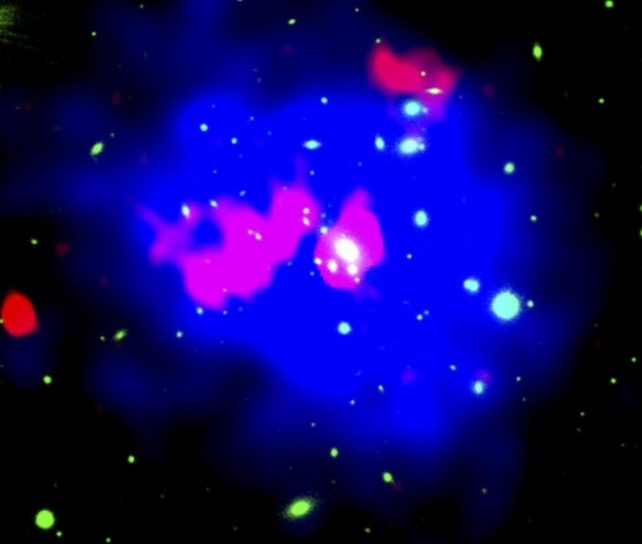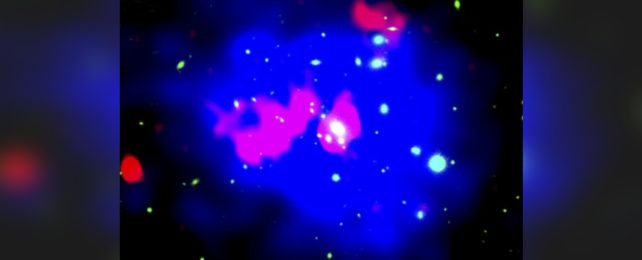If we had been around and able to see into the heart of galaxy cluster Abell 980 around 260 million years ago, we may have seen something very spectacular indeed.
The brightest galaxy in the cluster erupted, the result of activity from its supermassive black hole, an event that would go on to blow massive bubbles emitting radio light out into space.
In a new study, a team of astronomers led by Surajit Paul of Savitribai Phule Pune University in India say that these newly discovered bubbles – known as radio lobes, or a radio galaxy – are the oldest of their kind we've ever seen.
Moreover, a pair of younger lobes has been found. In a second paper, the same team traced these to the same parent galaxy, making the combined object a rare example of a double pair of lobes – suggesting that the galaxy's supermassive black hole has erupted episodically.

Since radio lobes can extend millions of light-years, much larger than the galaxies from which they erupt, they can affect the intergalactic medium, the tenuous gas between galaxies. Studying these structures can help us better understand this medium, as well as the recurrent, episodic activity of the supermassive black holes that create them.
Radio lobes are fairly common in the Universe. They are produced when a supermassive black hole has an active phase, slurping down matter from the space around it.
While most of the material falls onto the black hole, some of it is accelerated along the black hole's external magnetic field lines to its poles, where it is launched into space as two jets traveling at a significant percentage of light speed.
These jets punch into intergalactic space, where they expand into lobes that interact with the intergalactic medium. These lobes act as a synchrotron to accelerate electrons, producing radio emissions.
The problem is that they very rapidly fade away beyond our ability to detect them, and none have been found older than 100 million years old, as we view them. However, such relics can record valuable information about the conditions in which they formed.
Paul and his colleagues hypothesized that one environment likely to prolong their survival is the hot, relaxed medium of a low-mass and quiet galaxy cluster.
Using the Giant Metrewave Radio Telescope in India, they went looking in galaxy clusters for just such an environment – and they found one, in Abell 980, located around 2 billion light-years away. There, they detected faint radio structures – lobes that they were able to age to about 260 million years old, spanning a distance of 1.2 million light-years.
Next was identifying where the lobes had come from.
In a second paper, Krishna and his colleagues were able to trace it to the brightest galaxy in the cluster. Now, it can be found in the center of Abell 980; however, Krishna and his team showed that it wasn't always in that position. Over 260 million years or so, it migrated 250,000 light-years, from the position at which it emitted the first pair of lobes.
Once in the cluster center, the galaxy then erupted again, producing a second pair of lobes. Astronomers have found, to date, just a few dozen examples of galaxies that have been linked with two pairs of radio lobes, called double-double radio galaxies.
Because the parent galaxy of the two pairs of lobes in Abell 980 has migrated, separating the lobes, Krishna and his team have named these galaxies 'detached double-double radio galaxies'. It's also even rarer than double-double radio galaxies; just two other candidates have been reported, making this discovery the most plausible example yet, the researchers say.
Future, more sensitive radio observations may yield even more examples, helping shed light on the recurrent nature of supermassive black hole outbursts.
The two papers are currently in press with Astronomy & Astrophysics and Publications of the Astronomical Society of Australia, respectively. They can be found here and here.
